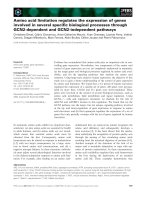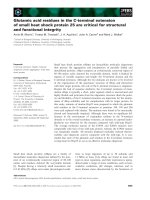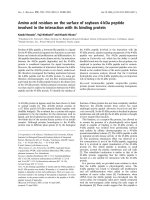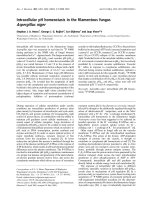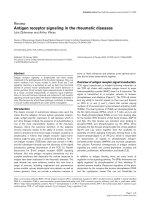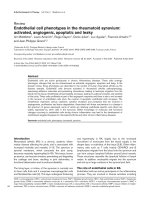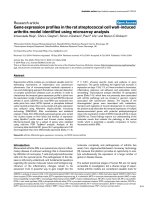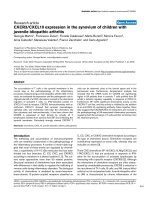Báo cáo y học: "Amino acid substitutions in the E2 glycoprotein of Sindbis-like virus XJ-160 confer the ability to undergo heparan sulfate-dependent infection of mouse embryonic fibroblasts" docx
Bạn đang xem bản rút gọn của tài liệu. Xem và tải ngay bản đầy đủ của tài liệu tại đây (415.14 KB, 6 trang )
SHOR T REPOR T Open Access
Amino acid substitutions in the E2 glycoprotein
of Sindbis-like virus XJ-160 confer the ability to
undergo heparan sulfate-dependent infection of
mouse embryonic fibroblasts
Wuyang Zhu
1
, Shihong Fu
1
, Ying He
1
, Jinping Li
2
, Guodong Liang
1*
Abstract
We have recently demonstrated an essential role of the domain of 145-150 amino acid in the E2 glycoprotein of
Sindbis virus in the interaction with cellular heparan sulfate (HS) and in the infection of mouse embryonic fibro-
blasts (MEF) cells. In this study, we constructed and characterized the mutants of Sindbis-like virus XJ-160 in which
Tyr-146 and/or Asn-149 in the E2 glycoprotein had been substituted with His and Arg, respectively. Unlike parental
virus XJ-160, mutants with either or both substitutions were able to infect wild-type mouse embryonic fibroblasts
(MEF-wt) or MEF-Epi
-/-
cells which produce mutant HS. Significantly more infectious particles were released from
MEF-wt than from MEF-Epi
-/-
cells. The mutant virus with both substitutions release was inhibited by pre-incubation
of virus with heparin or pre-treatment of BHK-21 cells with HS-degrading enzyme. Both XJ-160 and the mutant
viruses retained substantial neurovirulence in suckling mice. Our findings provide further support to the importance
of positively charged residues in the HS-binding site of E2 in mediating Sindbis virus infection of MEF cells.
Findings
Sindbis virus (SINV) is considered the prototype of Alpha-
virus genus, Togaviridae family [1,2]. Nearly 30 members
of the genus are widely distributed in all continents except
in the Antarc tic. Sindbis viru s is an enveloped virus with
an 11.5 kb genome of single stranded RNA. The viral
genome with a 5’ terminal methylguanylate cap and a 3’
terminal polyadenylate tail encodes four nonstructural
proteins (nsP1-4) and three mature structural proteins
(capsid, E2 and E1). Based on the divergence of nucleotide
sequencing and biological characteristics, Sindbis virus can
be divided into two groups, SINV and Sindbis-like virus
(SINLV) [3]. SINV YN87448 and SINLV XJ-160 were iso-
lated from a pool of Anopheles mosquitoes collected in
Xinjiang and from a female patient with fever in Yunnan,
China [4,5].
Heparan sulfate ( HS) is a complex polysaccha ride
expressed in the form of proteoglycans on the surfaces
of a wide range of invertebrate and vertebrate cells.
Recently, HS has been found to be involved in the infec-
tion and pathogenicity of SINV [6,7] and other alpha-
viruses, such as Venezuelan encephalitis virus (VEEV),
Semliki Forest v irus (SFV) and Ross River virus (RRV)
[8,9]. These investigations indicate that HS-dependent
infection is an adaptation through the mutation for
positively charged amino acid (aa), which frequently
arise in laboratory strains during repeated passaging cul-
ture, and that wild-type strains of SINV might not bind
well to HS. Besides alphaviruses, HS has been shown to
serve as a receptor of a number of viruses, including
herpes simplex virus (HSV) [10], human immunodefi-
ciency virus type 1 (HIV-1) [11], adeno-associated virus
type 2 (AAV2) [12], respiratory syncytial virus (RSV)
[13], foot-and-mouth disease virus (FMDV) [14], a nd
human papillomavirus type 11 [15].
Based on the difference in HS-dependent infectivity
between YN87448 virus and XJ-160 virus, we have con-
firmed that interaction of E2 protein with HS is crucial
for cellular infection of SINV [16]. Importantly, specific
interaction of E2 peptide from YN87448 with heparin
* Correspondence:
1
State Key Laboratory for Infectious Disease Prevention and Control (SKLID),
Institute for Viral Disease Control and Prevention, China CDC, Beijing, China
Full list of author information is available at the end of the article
Zhu et al. Virology Journal 2010, 7:225
/>© 2010 Zhu et al; licensee BioMed Central Ltd. This is an Open Access article distributed under the terms of the Creative Commons
Attribution License ( s/by/2.0), which perm its unrestricted use, distribution, and reproduction in
any medium, provided the original work is properly cited.
further suggests that the domain of 145-150 amino acid
(aa) from the E2 gene may be a molecular basis for the
specific interaction of SINV with cellular HS. Alignment
of the E2 glycoprotein sequences from YN87448 and
XJ-160 revealed the differences at the domain where the
two positively charged aa (His and A rg at 146 and 149,
respectively) of SINV YN87448 are neutral aa in SINLV
XJ-160. This may explain that SINLV XJ-160 is no t HS-
dependent in infection of cells due to lacking of the two
basic amino acids in the second HS-binding domain.
Specific interaction of the peptide containing 145-150 aa
from YN87448 E2 gene with heparin and no binding of
the corresponding peptide f rom the of XJ-160 E2 gene
to heparin further strengthened this speculation. How-
ever, the effects of E2-146Tyr and E2-149Asn on HS
binding of Sindbis virus in the context of virus-RNA
remain to be confirmed.
To find out the effect E2-146Tyr and E2-149Asn on
HS-d epend ent infecion, three mutant viruses, BR-146 H
containi ng point mutation 146Y-H, BR-149R containing
149 N-R and BR-HR containing both mutations were
generated by in vitro transcription and electroporation
method as previously described [16,17]. The result s of
immunofluorescence assay (IFA) and plaque assay indi-
cated that XJ-160 virus was capable of assembling infec-
tious particles in spite of different site-directed mutation
at residue E2-146 or residu e E2-149, and that all the
mutant viruses displayed plaque morphologies similar to
those formed by XJ-160, although the mutants seem to
form bigger plaques (Additional file 1, Figure 1). In
addition, determination of the titers demonstrated that
BR-HR virus released more infectious particles than
either parental virus XJ-160 or other two mutants
(Additional file 2, Figure 2).
To investigate the correlation between the mutants and
cellular HS, we have compared infectivity of the mutants
and XJ-160 virus in wild-type mouse embryonic fibro-
blast (MEF-wt) cells with that in two mutant MEF cell
lines. The MEF-Ext
-/-
is derived from the mice that are
deficient in one of the HS polymerases, EXT1 [18], and
the MEF-Epi
-/-
isgeneratedfrommicethatarelacking
one of the modifications enzymes, glucuronyl C5-epi-
merase [19]. Characterization of the MEF cells generated
from the mutant embryos illustrated that the MEF-Ext
-/-
expressed a HS that is normal in composition, but is
significantly shorter in chain length (20 kDa), in com-
parison to the wild-type HS (70 kDa) [20]; while the
MEF-Epi
-/-
cells expressed a full-length HS with a def ec-
tive structure, e.g. lacking iduronic acid units and 2-O-
sulfation accompanied with increased N-sulfation [21].
And three MEF cell lines (MEF-wt,MEF-Epi
-/
and
MEF-Ext
-/- -
) used in this study was kindly provided b y
Dr Jin-ping Li, University of Uppsala, Sweden. MEF-
Ext
-/-
cells were resistant to all of viruses, likely due to
the shorter HS chains expressed on their cell surface,
indicating that the chain length of HS on cell surface is
critical for viral attachment. In contrast, YN87448 and
all the mutants were able to infect MEF-wt and MEF-
Epi
-/-
cells as demonstrated by IFA ( Figure 1a). These
results suggest that substitution at residue E2-146 or
residue E2-149 could help XJ-160 virus to overcome the
MEF infection block by discriminating cellular HS.
It should be point out that either the mutants or
YN87448 displayed considerably weaker infectivity in
MEF-Epi
-/-
cellsincomparisontothatinMEF-wt cells
(Figure 1a). Quantification of the mutant viruses in cul-
ture medium clearly revealed different kinetics of viral
reproduction in MEF-wt cells and MEF-Epi
-/-
cells. All
the mutants reach growth plateau approximately 84 h
post-infection (h p. i.), but the reproduction ability var-
ies, in the o rder of BR-HR, BR-149R and BR-HR in
either MEF-wt cells or MEF-Epi
-/-
cells (Figure 1b,c).
More importantly, each virus released 2-3 order of mag-
nitude more infectious particles in MEF-wt cells than
that in MEF- Epi
-/-
cells (Figure 1b,c). In c onsideration
ofthefactthat2-O-sulfatediduronicacidresidueis
commonly found in the HS sequences that interact with
proteins (16), the reduced infectivity of the viruses to
MEF-Epi
-/-
cells in comparison to the MET-wt cells is
likely due to the structural alterations of the surface HS
that has a weaker interaction with E2 protein, suggesting
that the fine structure of HS on cell surface is critical
for viral attachment and infection. Indeed, the mutant
HS from MEF-Epi
-/-
exhibited an aberrant interaction
with growth factors. Further studies to test the infection
of the viruses on a 2-O-sulfotransferase mutant cell may
provide additional information to this end.
Heparin, an analog of HS, is commonly used as a
replacement of H S in in vitro experiments [22] and has
been reported to be able to block Sindbis virus to infect
and form plaques in cells [7]. Bacterial produced hepari-
nase I that cleaves heparin and cellular HS has been
commonly used to remove cell surface HS f or various
biological studies [23]. To further identify the functions
of substitution at E2-146 or E2-149 on HS-dependent
infection, we applied heparin or heparinase I to pre-
incubate virus or BHK-21 cell, respectively. Pre-incuba-
tion of heparin with the viruses resulted in different
inhibition of viral infection in BHK-21 cells. BR-149R
and BR-HR showed a about inhibition of 20% and 50%
at the concentration of 100 μg/ml, while addition of
heparin had marginal effect on the plaque formation of
BR-146 H (Figure 2a). Together with the similar effect
of heparinase I treatment (Figure 2b), w e can conclude
that the simultaneous substitutions at E2-146Tyr and
E2-149Asn enhance HS-dependent infection by XJ-160,
especially substitution of E2-149 N-R plays an important
role in HS-dependent infection. In the absence of crystal
Zhu et al. Virology Journal 2010, 7:225
/>Page 2 of 6
Figure 1 Infectivity of recombinant viruses on MEF cell. (a) Comparison of viral infections to MEF cells. MEF cells were grown on cover slips
to 80% confluent and infected with YN87448 and XJ-160 as well as the mutants for 48 hours. Antiserum against YN87448 (used in YN87448) or
XJ-160 (used in XJ-160 panel and each of recombinant virus) diluted1:100 were applied for IFA as previously described [16]. Non-infected MEF
cells were used as control; Monolayer of MEF-wt (b) and MEF-Epi-/-cells (c) were infected with recombinant or parental viruses at a MOI of 0.01,
the medium (1 ml) was removed at the indicated time points and evaluated for virus titer by plaque assay. Each point represents the mean ±
SD of three wells.
Zhu et al. Virology Journal 2010, 7:225
/>Page 3 of 6
Figure 2 Effect of heparin or heparinase I treatment on plaque formation of mutant viruses. (a) Viruses diluted to 100-200 PFU/200 μl
were incubated with heparin at the concentrations indicated for 1 h at 37°C. Then the plaque assay was performed on BHK-21 cells as
previously described [16]. (b) Confluent BHK-21 cell monolayers were treated with heparinase I at the concentrations as indicated. After washing
three times with PBS, the cells were infected with viruses diluted to 100-200 PFU in 200 μl. Plaque formation was analyzed as described.
Figure 3 Neurovi rulence of the viruses for suckling mi ce. Suckling mice (three days old) were inoculated intracereb rally wi th 30 μlof10
3
PFU/ml recombinant or parental viruses; equal volume of Eagle’s fortified with 1% fetal bovine serum was used as control.
Zhu et al. Virology Journal 2010, 7:225
/>Page 4 of 6
structural information about the Alphavirus E2 glyco-
protein, it is difficult to predict that any particular
amino acid is part of a binding site for HS or even that
the amino acid is exposed on the surface of the virion.
However, together with the notion that binding sites of
SINV to HS are composed of the linear HS-binding
domains and the scattered positively charged aa [16],
our data demonstrate the import ance of positively
charged residues in the HS-binding domain of E2 in
mediating SINV infection.
Increased binding of alphaviruses to HS usually
results in smaller plaque size under agar, more rapid
clearance from the blood, and higher neurovirulence
when inoculated directed into the brain of mice
[16,24-27]. Here, we show that the mutants with par-
tial HS-dependent phenotype in comparison to XJ-160
caused bigger plaques on BHK-21 cells and exhibited
less neurovirulent in suckling mice than parental virus
did. As shown in Figure 3, similar to XJ-160 virus is
that all the mutants showed fatal neurovirulence in
suckling mice. However, XJ-160 virus killed all animals
about 7 days after inoculation. In contrast, BR-146 H,
BR-149R and BR-HR only killed 50%, 40% and 80% of
mice 10 days after inoculation (Figure 3). Consistence
with our data is that the increased binding to cellular
HS is associated with loss of neurovirulence of Murray
Valley encephalitis virus [28]. In contrast, decreased
HS binding resulted in loss of neurovirulence of Thei-
lers murine encephalomyelitis virus [29]. The distinct
effects of HS-binding on viral neurovirulence suggest
that the two parameters are relatively separable, and
that other properties of the virus play an important
role for viral neurovirulence.
Additional material
Additional file 1: Figure 1 Infectivity of the mutant viruses in BHK-
21 cells. Cytopathic effect (CPE) 36 h postinfection (p.i.) (upper panels),
IFA 48 h p.i. (middle panels), and plaque-forming assay 24 h p.i. (lower
panels) of parental virus and the mutants were observed in BHK-21 cells.
Additional file 2: Figure 2 Growth curves of mutant viruses and the
parental viruses. Monolayer of BHK-21 cells at 80% confluency was
infected with parental viruses and recombinant viruses at a multiplicity of
infection of 0.01. The medium (1 ml) was removed on hours 20, 24, 28,
32, 36 and 44 h p. i., and frozen for later determination of virus titers,
and equal volume of fresh medium was added. The virus titers are
shown as the mean ± SD of 3 replicate experiments.
Acknowledgements
This work was supported by the grants from the National Natural Science
Foundation of China (No. 30970160), the Major Science and Technology
Project for Infectious Disease (No. 2008ZX10004-001; 2009ZX10004-705), the
Development Grant of State Key Laboratory for Infectious Disease Prevention
and Control (2008SKLID105) and the Swedish Research Council (K2009-67X-
21128-01-3).
Author details
1
State Key Laboratory for Infectious Disease Prevention and Control (SKLID),
Institute for Viral Disease Control and Prevention, China CDC, Beijing, China.
2
Department of Medical Biochemistry and Microbiology, University of
Uppsala, The Biomedical Center, Uppsala, Sweden.
Authors’ contributions
WZ carried out the molecular genetic studies, participated in the sequence
alignment and drafted the manuscript. SF carried out the immunoassays. YH
participated in the sequence alignment. JL participated in the design of the
study and performed the statistical analysis. GL conceived of the study, and
participated in its design and coordination. All authors read and approved
the final manuscript.
Competing interests
The authors declare that they have no competing interest s.
Received: 29 July 2010 Accepted: 14 September 2010
Published: 14 September 2010
References
1. Taylor RM, Hurlbut HS, Work TH, Kingsbury JR, Frothingham TE: Sindbis
virus: a newly recognized arthropod-transmitted virus. Am J Trop Med
Hyg 1955, 4:844-846.
2. Doherty RL, Carley JG, Kay BH, Filippich C, Marks EN, Frazier CL: Isolation of
virus strains from mosquitoes collected in Queensland 1972-1976. Aust.
J Exp Biol Med Sci 1979, 57:509-520.
3. Strauss JH, Strauss EG: The alphaviruses: gene expression, replication, and
evolution. Microbiol Rev 1994, 58:491-562.
4. Liang GD, Li L, Zhou GL, Fu SH, Li QP, Li FS, He HH, Jin Q, He Y, Chen BQ,
Hou YD: Isolation and complete nucleotide sequence of a Chinese
Sindbis-like virus. J Gen Virol 2000, 81:1347-1351.
5. Zhou GL, Liang GD, Li L, Fu SH, Zhang HL: Sequencing analysis of the
genome of YN87448 virus, first isolated in China. Zhonghua Shi Yan He
Lin Chuang Bing Du Xue Za Zhi 1998, 12:81.
6. Byrnes AP, Griffin DE: Binding of Sindbis virus to cell surface heparan
sulfate. J Virol 1998, 72:7349-7356.
7. Klimstra WB, Ryman KD, Johnston RE: Adaptation of Sindbis virus to BHK
cells selects for use of heparan sulfate as an attachment receptor. J Virol
1998, 72:7357-7366.
8. Bernard KA, Klimstra WB, Johnston RE: Mutations in the E2 glycoprotein of
Venezuelan equine encephalitis virus confer heparan sulfate interaction,
low morbidity, and rapid clearance from blood of mice. Virology 2000,
276:93-103.
9. Heil ML, Albee A, Strauss JH, Kuhn RJ: An amino acid substitution in the
coding region of the E2 glycoprotein adapts Ross River virus to utilize
heparan sulfate as an attachment moiety. J Virol 2001, 75:6303-6309.
10. WuDunn , Spear PG: Initial interaction of herpes simplex virus with cells
is binding to heparan sulfate. J Virol 1989, 63:52-58.
11. Patel M, Yanagishita M, Roderiquez G, Bou-Habib DC, Oravecz T, Hascall VC,
Norcross MA: Cell-surface heparan sulfate proteoglycan mediates HIV-1
infection of T-cell lines. AIDS Res Hum Retroviruses 1993, 9:167-174.
12. Summerford C, Samulski RJ: Membrane-associated heparan sulfate
proteoglycan is a receptor for adeno-associated virus type 2 virions. J
Virol 1998, 72:1438-1445.
13. Krusat T, Streckert HJ: Heparin-dependent attachment of respiratory
syncytial virus (RSV) to host cells. Arch Virol 1997, 142:1247-1254.
14. Jackson T, Ellard FM, Ghazaleh RA, Brookes SM, Blakemore WE, Corteyn AH,
Stuart DI, Newman JW, King AM: Efficient infection of cells in culture by
type O foot-and-mouth disease virus requires binding to cell surface
heparan sulfate. J Virol
1996, 70:5282-5287.
15. Joyce JG, Tung JS, Przysiecki CT, Cook JC, Lehman ED, Sands JA, Jansen KU,
Keller PM: The L1 major capsid protein of human papillomavirus type 11
recombinant virus-like particles interacts with heparin and cell-surface
glycosaminoglycans on human keratinocytes. J Biol Chem 1999, 274:5810.
16. Zhu W, Wang L, Yang Y, Jia J, Fu S, He Y, Li JP, Liang G: Interaction of E2
Glycoprotein with Heparan Sulfate Is Crucial for Cellular Infection of
Sindbis Virus. PLoS ONE 2010, 5(3):e9656.
Zhu et al. Virology Journal 2010, 7:225
/>Page 5 of 6
17. Zhu WY, Yang YL, Fu SH, Wang LH, Zhai YG, Tang Q, Liang GD:
Substitutions of 169Lys and 173Thr in nonstructural protein 1 influence
the infectivity and pathogenicity of XJ-160 virus. Arch Virol 2009,
154:245-253.
18. Mitchell KJ, Pinson KI, Kelly OG, Brennan J, Zupicich J, Scherz P,
Leighton PA, Goodrich LV, Lu X, Avery BJ, Tate P, Dill K, Pangilinan E,
Wakenight P, Tessier-Lavigne M, Skarnes WC: Functional analysis of
secreted and transmembrane proteins critical to mouse development.
Nat Genet 2001, 28:241-249.
19. Li JP, Gong F, Hagner-McWhirter Å, Forsberg E, Åbrink M, Kisilevsky R,
Zhang X, Lindahl U: Targeted disruption of a murine glucuronyl C5-
epimerase gene results in heparan sulfate lacking L-iduronic acid and in
neonatal lethality. J Biol Chem 2003, 278:28363-28366.
20. Yamada S, Busse M, Ueno M, Kelly OG, Skarnes WC, Sugahara K, Kusche-
Gullberg M: Embryonic fibroblasts with a gene trap mutation in Ext1
produce short heparan sulfate chains. J Biol Chem 2004, 279:32134-32141.
21. Jia J, Maccarana M, Zhang X, Bespalov M, Lindahl U, Li JP: Lack of L-
iduronic acid in heparan sulfate affects interaction with growth factors
and cell signaling. J Biol Chem 2009, 284:15942-15950.
22. Kakkar AK, Levine MN, Kadziola Z, Lemoine NR, Low V, Patel HK, Rustin G,
Thomas M, Quigley M, Williamson RC: Low molecular weight heparin,
therapy with dalteparin, and survival in advanced cancer:the fragmin
advanced malignancy outcome study (FAMOUS). J Clin Oncol 2004,
22:1944-1948.
23. Desai UR, Wang HM, Linhardt RJ: Specificity studies on the heparin lyases
from Flavobacterium heparinum. Biochemistry 1993, 32:8140-8145.
24. Bear JS, Byrnes AP, Griffin DE: Heparin-binding and patterns of virulence
for two recombinant strains of Sindbis virus. Virology 2006, 347:183-190.
25. Byrnes AP, Griffin DE: Large-plaque mutants of Sindbis virus show
reduced binding to heparin sulfate, heightened virema, and slower
clearance from circulation. J Virol 2000, 74:644-651.
26. Klimstra WB, Ryman KD, Bernard KA, Nguyen KB, Biron CA, Johnston RE:
Infection of neonatal mice with sindbis virus results in a systemic
inflammatory response syndrome. J Virol 1999, 73:10387-10398.
27. Ryman KD, Gardner CL, Burke CW, Meier KC, Thompson JM, Klimstra WB:
Heparan sulfate binding can contribute to the neurovirulence of
neuroadapted and nonneuroadapted Sindbis viruses. J Virol 2007,
81:3563-3573.
28. Lee E, Lobigs M: Substitutions at the putative receptor-binding site of an
encephalitic flavivirus alter virulence and host cell tropism and reveal a
role for glycosaminoglycans in entry. J Virol 2000, 74:8867-8875.
29. Reddi HV, Manoj Kumar AS, Kung AY, Kallio PD, Schlitt BP, Lipton HL:
Heparan sulfate-independent infection attenuates high-neurovirulence
GDVII virus-induced encephalitis. J Virol 2004, 78:8909-8916.
doi:10.1186/1743-422X-7-225
Cite this article as: Zhu et al.: Amino acid substitutions in the E2
glycoprotein of Sindbis-like virus XJ-160 confer the ability to undergo
heparan sulfate-dependent infection of mouse embryonic fibroblasts.
Virology Journal 2010 7:225.
Submit your next manuscript to BioMed Central
and take full advantage of:
• Convenient online submission
• Thorough peer review
• No space constraints or color figure charges
• Immediate publication on acceptance
• Inclusion in PubMed, CAS, Scopus and Google Scholar
• Research which is freely available for redistribution
Submit your manuscript at
www.biomedcentral.com/submit
Zhu et al. Virology Journal 2010, 7:225
/>Page 6 of 6
